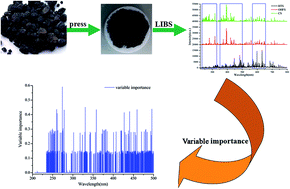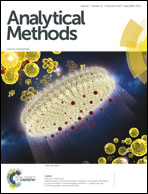Classification of different types of slag samples by laser-induced breakdown spectroscopy (LIBS) coupled with random forest based on variable importance (VIRF)
Abstract
A laser induced breakdown spectroscopy (LIBS) technique coupled with random forest based on variable importance (VIRF) was proposed to perform the classification analysis of slag samples. Three types of slag samples (open-hearth furnace slag, converter slag and high titanium slag) were identified and classified by a random forest (RF) method with different pre-processing methods (normalized with maximum integrated intensity, first-order derivative and second-order derivative) and different input variables (200–300, 200–400, 200–500, 200–600, 200–700 and 200–800 nm), and the importance of the input variable was employed to improve the classification performance of the RF model for slag samples. Averaged OOB (out-of-bag) error, sensitivity, specificity and accuracy were calculated to evaluate the classification performance of the RF model for slags. Normalized by maximum integrated intensity LIBS spectra (200–500 nm) of slag samples were used as the input variable to construct the PLS-DA, SVM, RF and VIRF models for the classification analysis of slags. The VIRF model shows a better classification performance than the other three models. The LIBS technique coupled with RF perhaps is a promising approach to achieve the online analysis and process control of slag and even industrial waste recycling.


 Please wait while we load your content...
Please wait while we load your content...